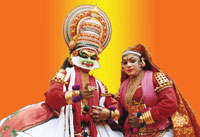Performing Arts
For ages, the rich and vibrant culture of Kerala has intrigued people worldwide. The real treasures of Kerala lay in the cultural heritage of its people. Kerala has its own typical art forms which reflect the life and outlook of the people. From the renowned Kathakali, considered to be the complete art form as it synthesizes all that is best in the fields of drama, music and dance, to the folk dances which are reflection of the rhythmic impulses of a sensitive people.
Chavittunatakom
A Christian art form of Kerala, evolved at the turn of the 16th Century AD during the Portuguese colonization and bears definite traces of the European Christian Miracle Plays. In this musical drama, the actors wear Greco-Roman costumes and even the stage props bear several foreign influences. In the past, the Chavittunatakom was performed on open stages, though sometimes the interior of a church was also a venue. The language is a colloquial mix of Tamil and Malayalam.
Kathakali
Kerala owes its transnational fame to this nearly 300 years old classical dance form which combines facets of ballet, opera, masque and the pantomime. It is said to have evolved from other performing arts like Kootiyattam, Krishnanattam and Kalarippayattu. Kathakali explicates ideas and stories from the Indian epics and Puranas.
Krishnanattam
The visual effect is enhanced by varied and colourful facial make-up with larger-than-life-masks, made of light wood and cloth padding, for certain characters. The characters who do not wear masks have specific facial colours applied within the frame of a white chutti. The predominant colours used are dark green, flesh tint and deep rose. Most of the characters wear red vests and flowing 'Uthariyams'. The characters of Krishna, Arjuna and Garuda wear dark blue vests.
Mohiniyattam
The sinuous dance of the enchantress, this is a distinctive classical dance form of Kerala. Slow, graceful, swaying movements of the body and limbs and highly emotive eye and hand gestures are unique to this dance form. The simple, elegant gold-filigreed dress, in pure white or ivory, is akin to the traditional attire of the women of Kerala.
Thullal
Thullal is a solo performance combining the dance and recitation of stories in verse. Staged during temple festivals, the performer explicates the verses through expressive gestures. The themes are based on mythology. This satiric art form was introduced in the18th century by the renowned poet Kunchan Nambiar.
Duffmuttu
Duffmuttu is also known as Aravanamuttu. It is a group performance popular among the Muslims of Malabar. Duffmuttu is staged as a social event during festivals and nuptial ceremonies.
Kolkkali
Kolkkali is a highly rhythmic folk art. The dancers wielding short pairs of sticks move in circles around a nilavilakku as they sing and dance tapping each other’s stick. Though the dancers break away to form different patterns, they never miss a beat. In Malabar, Kolkkali is more popular among Muslim men.
Kutiyattam
Kutiyattam literally means "acting together". This is the earliest classical dramatic art form of Kerala. Based on Sage Bharatha's'Natyasasthra' who lived in the second century, Kutiyattam evolved in the 9th century AD.
Oppana
A dance form essential to the wedding entertainment and festivities of the Malabar Muslims. Maidens and young female relatives sing and dance around the bride, clapping their hands. The songs of Mappilappattu are first sung by the leader and are repeated by the chorus. The themes are often teasing comments and innuendoes about the bride's anticipated nuptial bliss. Oppana is often presented as a stage item today.
Kakkarissi Natakom
Kakkarissi Natakom is a satirical dance-drama based on the puranic legends of Lord Siva and his consort Parvati when they assumed human forms as Kakkalan and Kakkathi - a nomadic tribe of fortune tellers.
Koothu
Koothu is a socio-religious art performed in the Koothambalam or the Koothuthara of temples, either independently or as part of Kootiyattam. It is a solo narrative performance interspersed with mime and comic interludes. The Chakkiar dons the role of 'Vidushaka'or the wise jester.
Margomkali
Margomkali is a ritual folk art of the Syrian Christians of Kottayam and Thrissur districts. A dozen dancers sing and dance around a lighted wick lamp (Nilavilakku), clad in the simple traditional white dhoti and sporting a peacock feather on the turban to add a touch of colour. This is an allegorical enactment with the lamp representing Christ and the performers his disciples.
Thiruvathirakali
Thiruvathirakali is a dance performed by women, in order to attain everlasting marital bliss, on Thiruvathirakali day in the Malayalam month of Dhanu (December- January). The dance is a celebration of marital fidelity and the female energy, for this is what brought Kamadeva (the god of love) back to life after he was reduced to ashes by the ire of Lord Siva.










